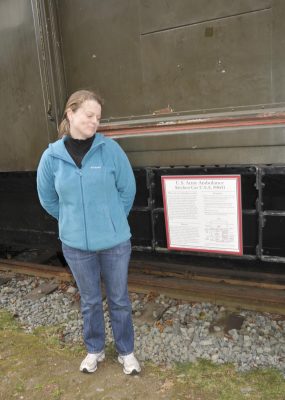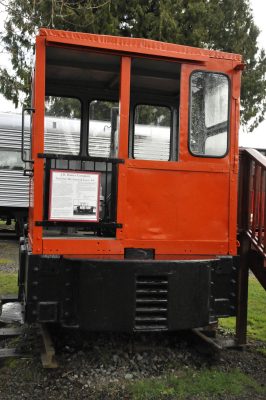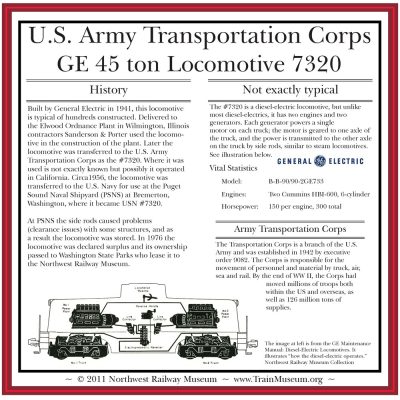
Cunningham poses with the new Kitchen car sign. The sign is affixed to the steps below the large sliding door located at the middle of the car.
Thanks to a recent donation from the 4th Division/Pacific Northwest Region/National Model Railroad Association specifically marked for education, the Museum has designed and produced three new interpretive signs for large objects at the Snoqualmie Depot. The signs were fabricated by Fossil Industries, Inc. in New York. Fossil is considered a leader in outdoor sign fabrication. (From their website: “The World’s most durable signs and murals.”) For those familiar with the Centennial Trail signs, Chinook Signs Inc. designed the interpretive panels and Fossil fabricated them. (Chinook Signs Inc. also designed and fabricated the sign stands.)
The Museum’s Educator, Jessie Cunningham, is responsible for all exhibits and interpretation at the Museum. She worked closely with Fossil – in what turned out to be a lengthy process – to order the new signs. The first step was getting a quote to determine if signs were in the budget – they were. Cunningham and Executive Director Richard Anderson determined the three objects to create signs for. All three large objects will remain at the Snoqualmie Depot for the foreseeable future – which is why they were selected: Army Ambulance Kitchen car 89601, J.H. Baxter Co. locomotive 6-C, and Army Transportation Corps locomotive 7320 (also known as Cecil the Diesel). Each large object now has a new 17” x 17” sign.
Cunningham designed a template that was complimentary to the outdoor signs already at the Depot, as well as the Centennial Trail. Instead of being rectangular in shape, these new signs are square but feature similar design components. Sign content is a combination of both previously written and new material. Each sign also contains a minimum of one image. Volunteers Rich W. and Bob L. assisted with historical and technical accuracy. The revision process was long but necessary to insure the best product possible. Once Fossil received final approval it took six weeks to receive the sign order.

Locomotive 6-C is a popular destination at the Museum, since children are invited to climb in the locomotive and “drive the train.” Now parents can learn all about the history of the locomotive while they keep a close eye on their children.
One aspect of sign design that was really important was determining how and where to affix the signs to the artifacts. Two of the three artifacts move around the site at the Depot, depending on the season and special event. So the Museum needed to be able to move the signs from side to side, depending on which track the car or locomotive was on. Another important part of this was determining how to affix the signs, since it was important to avoid permanently damaging the artifact (drilling holes, etc.). Cunningham submitted photographs and detailed measurements which Fossil used to design special hardware for each sign.
The Museum is thrilled to add these new signs to the Depot’s exhibits. This additional interpretation will enhance the visitor experience. Don’t forget to check out the new signs next time you are at the Depot!


